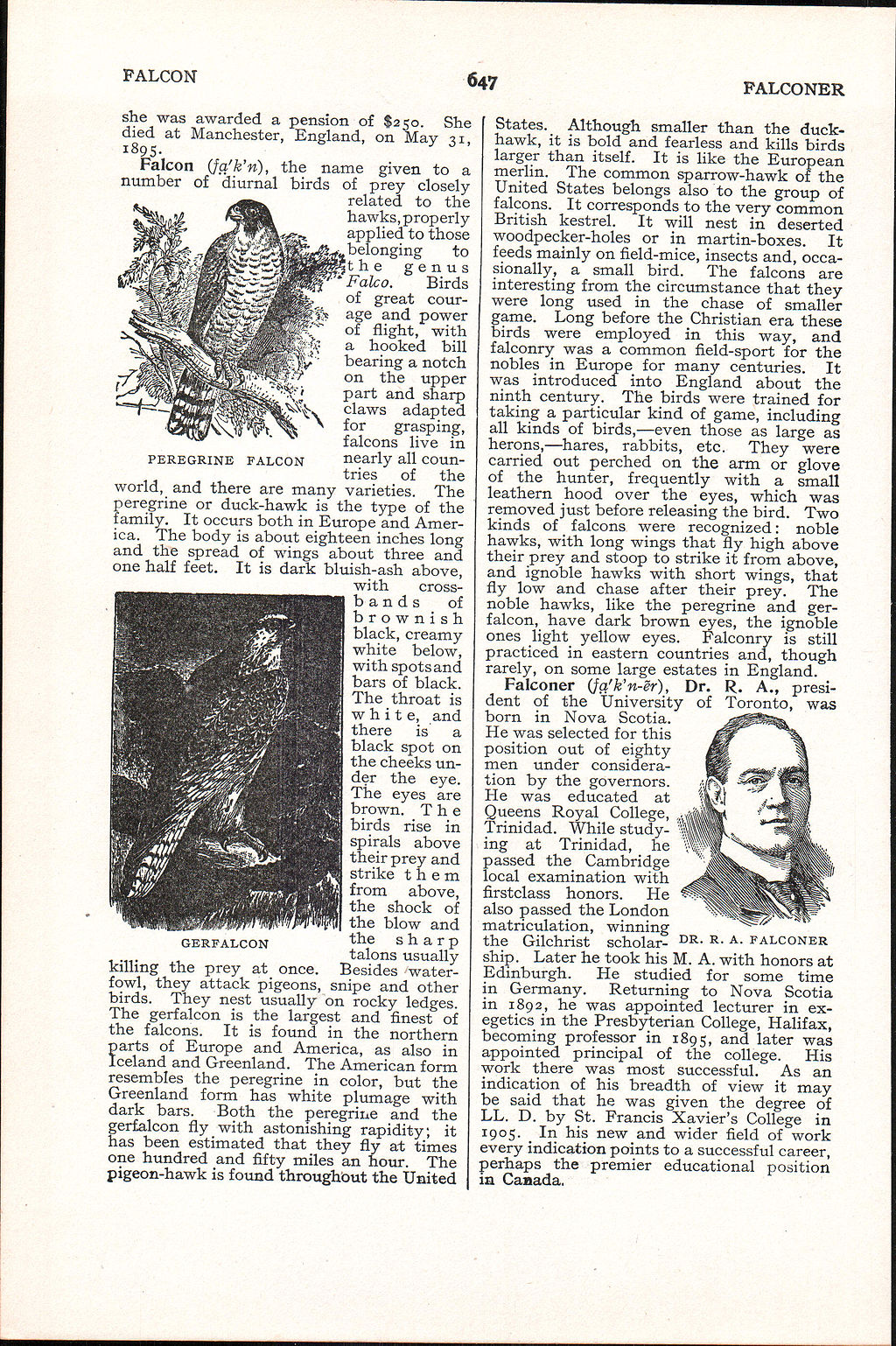FALCON
647
FALCONER
PEREGRINE FALCON
she was awarded a pension of $250. She died at Manchester, England, on May 31, 1895.
Falcon (fa'k'n), the name given to a number of diurnal birds of prey closely
related to the hawks, properly applied to those belonging to |t h e genus " Falco. Birds of great courage and power of flight, with a hooked bill bearing a notch on the upper part and sharp claws adapted for grasping, falcons live in nearly all countries of the world, and there are many varieties. The peregrine or duck-hawk is the type of the family. It occurs both in Europe and America. The body is about eighteen inches long and the spread of wings about three and one half feet. It is dark bluish-ash above,
with cross-bands of brownish black, creamy white below, with spots and bars of black. The throat is white, and there is a black spot on the cheeks under the eye. The eyes are brown. The birds rise in spirals above their prey and strike them from above, the shock of the blow and the sharp talons usually killing the prey at once. Besides waterfowl, they attack pigeons, snipe and other birds. They nest usually on rocky ledges. The gerfalcon is the largest and finest of the falcons. It is found in the northern parts of Europe and America, as also in Iceland and Greenland. The American form resembles the peregrine in color, but the Greenland form has white plumage with dark bars. Both the peregrine and the
gerfalcon fly with astonishing rapidity; it as been estimated that they fly at times one hundred and fifty miles an hour. The pigeon-hawk is found throughout the United
GERFALCON
States. Although smaller than the duck-hawk, it is bold and fearless and kills birds larger than itself. It is like the European merlin. The common sparrow-hawk of the United States belongs also to the group of falcons. It corresponds to the very common British kestrel. It will nest in deserted woodpecker-holes or in martin-boxes. It feeds mainly on field-mice, insects and, occasionally, a small bird. The falcons are interesting from the circumstance that they were long used in the chase of smaller game. Long before the Christian era these birds were employed in this way, and falconry was a common field-sport for the nobles in Europe for many centuries. It was introduced into England about the ninth century. The birds were trained for taking a particular kind of game, including all kinds of birds,—even those as large as herons,—hares, rabbits, etc. They were carried out perched on the arm or glove of the hunter, frequently with a small leathern hood over the eyes, which was removed just before releasing the bird. Two kinds of falcons were recognized: noble hawks, with long wings that fly high above their prey and stoop to strike it from above, and ignoble hawks with short wings, that fly low and chase after their prey. The noble hawks, like the peregrine and gerfalcon, have dark brown eyes, the ignoble ones light yellow eyes. Falconry is still practiced in eastern countries and, though rarely, on some large estates in England.
Falconer (fa'k'n-er), Dr. R. A., president of the University of Toronto, was born in Nova Scotia. He was selected for this position out of eighty men under consideration by the governors. He was educated at Queens Royal College, , Trinidad. While study- ' ing at Trinidad, he passed the Cambridge local examination with firstclass honors. He also passed the London matriculation, winning the Gilchrist scholarship. Later he took his M. A. with honors at Edinburgh. He studied for some time in Germany. Returning to Nova Scotia in 1892, he was appointed lecturer in ex-egetics in the Presbyterian College, Halifax, becoming professor in 1895, and later was appointed principal of the college. His work there was most successful. As an indication of his breadth of view it may be said that he was given the degree of LL. D. by St. Francis Xavier's College in 1905. In his new and wider field of work every indication points to a successful career, perhaps the premier educational position m Canada,
DR. R. A. FALCONER
